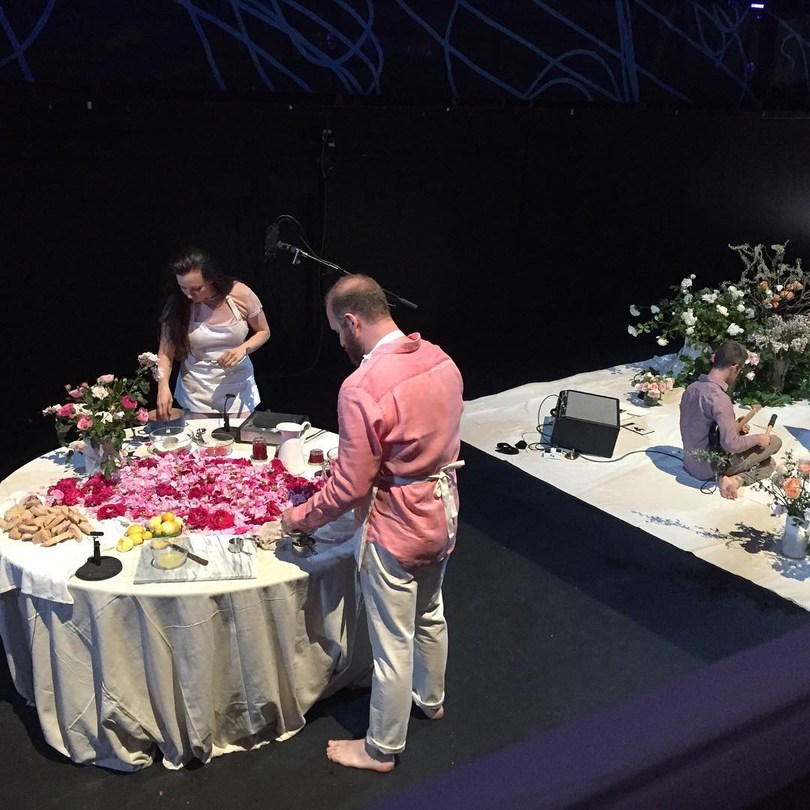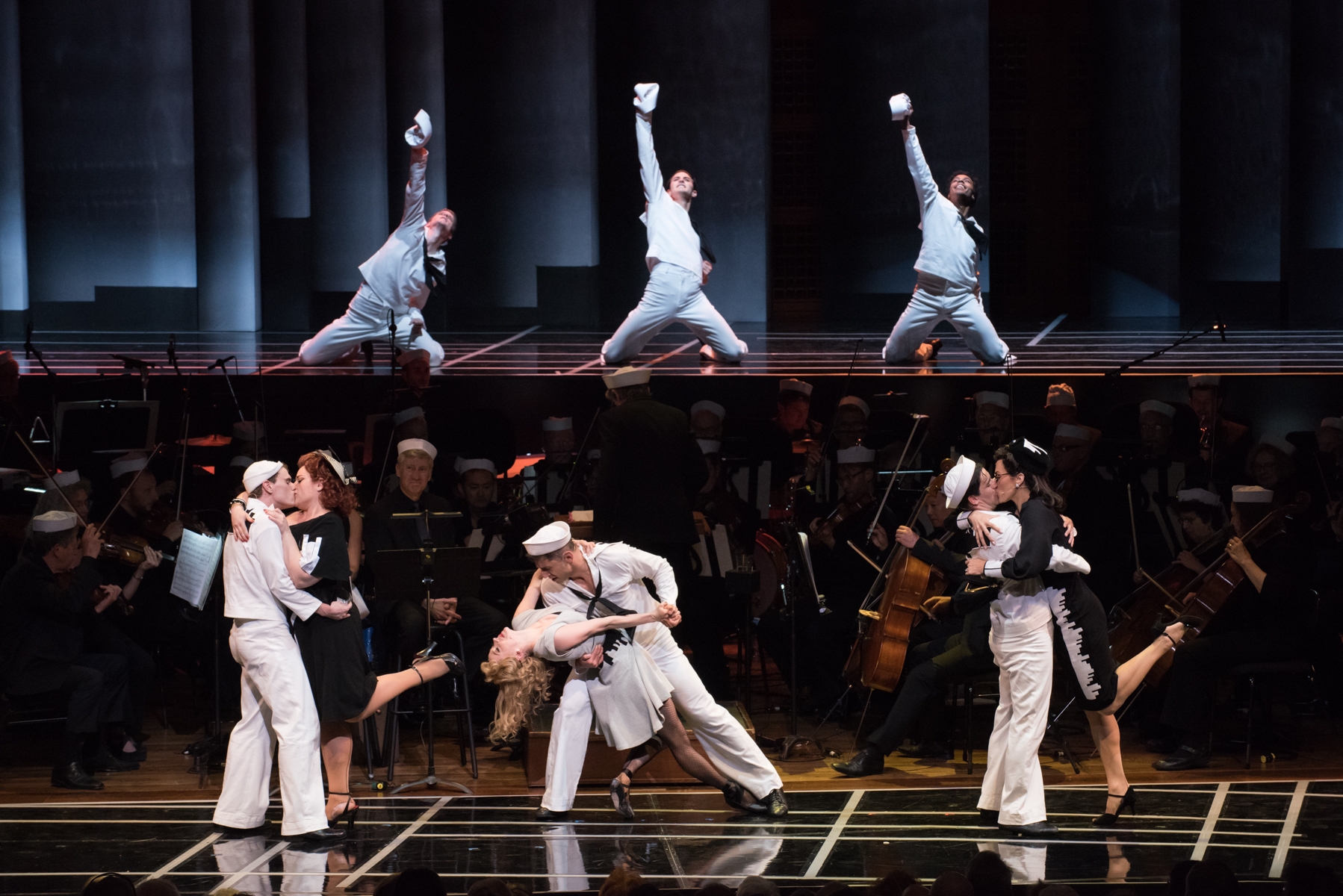In the pink

Though homeless, you make a shrine wherever you are. Photo by James Parr.
In the pink: the end of SoundBox season 2
Phew. For a moment I thought the San Francisco Symphony's SoundBox series was on the verge of becoming predictable.
The third and fourth programs of the second season, curated by SFS Chorus Director Ragnar Bohlin and Music Director Michael Tilson Thomas, were more or less exquisitely performed buffets of exotic choral extravagances and French rarities and oddities, but beyond the music they lacked a sense of imagination and surprise (unless one hadn't been to SoundBox before), as if those in charge had found the formula for success and didn't want to toy with it beyond raising the prices by $10 and reconfiguring the seating to allow more people to find a place to sit down.
The finale of the five-program season, bearing the title Obsession & Creation and curated by L.A.'s Chromatic (director James Darrah, video designer Adam Larsen, conductor Christopher Rountree, and designer Peabody Southwell), had an abundance of what its recent predecessors lacked, and with an edge that left me wishing there was still more to come and convinced that the Symphony needs to place the series in the hands of a designated curator.
Upon entering the Zellerbach Rehearsal Space in the rear of Davies Symphony Hall, visitors were greeted with a strange, compelling installation by Chris Kallmyer entitled Though homeless, you make a shrine wherever you are, based the iconoclastic composer/instrument-maker Harry Partch's hatred of Bach's music and his love for making rose-petal jam in the nude in the yard of his Petaluma home. I'm not making this up. Although there wasn't any nudity on display here, it was amusing in its own twee way, especially since it was Rountree and Peabody making the jam in their bare feet and color-coordinated pink and off-white ensembles.
Still barefoot (as he would remain through the performance), at 9:00 p.m. Rountree bounded up to stage area, which included an intriguing-looking catwalk set in the center of the room, quickly realized he left the score somewhere behind him, dashed off to retrieve it, and returned to lead six of the Symphony's violinists, all amplified, in Ted Hearne's For the love of Charles Mingus, a scratchy, often noisy, sometimes gently beautiful (thank you Mariko Smiley), and occasionally pleasingly discordant nine minutes of music
Next came something marvelously unexpected, the neo-Wagnerian opening of Nathaniel Stookey's YTTE (Yield to Total Elation), which had Stookey (also barefoot and and color-coordinated) performing on an OOVE apart from the from the orchestra. The OOVE (the word is also slang for nose hair) is a "kinetic sound sculpture" designed by Oliver DiCicco which is kind of like a cross between a theremin and an amplified harp. The "Elation" of the title evoked strands of Tristan before weaving its way into more contemporary orchestral instrumentation (and flagging a bit in its busy middle) before surging toward its climax as it worked its way back toward the territory in which it began.
After the first intermission (really, one is more than enough), three dancers (Christopher Bordenave, Nicholas Korkos, and Sam Shapiro), again, all dressed in varying shades of pinks and off-whites, appeared in the room as Rountree led the musicians in Purcell's Fantasia on One Note. Depending on the depth of one's fondness for baroque music and lithe male bodies, the trio were either a welcome distraction or just a distraction as they contorted themselves around the room and scratched out chalk lines on the catwalk for no discernible reason. I found it to be the former, with their presence imbuing the piece with the aura of an avant-garde masque, an effect which was only heightened when the soprano Marnie Breckenridge suddenly appeared seemingly out of nowhere at end of the catwalk clad like a malevolent pink snow queen and stepped on to it to sing Stradella's “Queste Lagrime e Sospire” from the oratorio San Giovanni Battista. Breckenridge, who's sung memorably in local productions by West Edge Opera and Opera Parallèle, sang the aria with a ravishing clear tone, superb enunciation, and pretty much stole the show as she dragged the trio of dancers across the catwalk like willing slaves succumbing to her every tear and passionate sigh as they followed her into Purgatory.
On paper, following that all-too-brief triumph with Frederic Rzewski's Attica sounds like an absurd idea, but the juxtaposition worked brilliantly, illuminating the program's title while creating a compelling musical and spiritual link between two pieces composed more than 350 years apart.
After the second intermission came some orchestral Zappa: "Be-Bop Tango," "Outrage at Valdez," and "The Dog Breath Variations/Uncle Meat," all from the 1993 album Yellow Shark. I've long thought most of Zappa's music has more interesting ideas than good ones, and little I heard here convinced me otherwise, but 20 years ago I found Beethoven's Fidelio to be a huge bore and now I love it, so maybe one day I'll see the light on non-Apostrophe Zappa. On the positive side, programming Zappa is a license to misbehave, or at least get tacky, and the videos accompanying the pieces, complete with dancing rubber gloves groping bananas, swishing skirts, and rubber vagina dentatas, were a welcome dose of rude irreverence.
SoundBox returns next year, and it will undoubtedly continue to sell out quickly and remain a hot ticket. It's cultivated its own devoted audience, a large portion of which is noticeably distinct from the one attending concerts in the main hall. But after two seasons some questions need to be asked: first, how long can the SFS keep SoundBox interesting without a single, very creative vision guiding the programming and curating? Second, when is the SFS going to start programming concerts in the main hall that motivates the SoundBox audience to show up at the Grove Street entrance? Nothing in the Symphony's 2016/17 season suggests that's part of the plan and yet how is that not the plan? How long until the novelty wears off and the this highly desirable demographic begins to move on to the next cool and unusual entertainment? And finally, what does it mean that the SFS has committed to a third season of SoundBox but not a fourth? What's next?
Christopher Rountree, shoeless conductor in action. Photo by James Parr.
If you liked this, like A Beast on Facebook for more.







